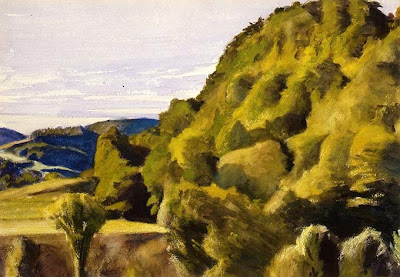Hopper the Activist
Edward Hopper, Bob Slater’s Hill, 1938, watercolor on paper, 13 1/4 x 19 1/2 inches. Huntington Museum of Art, Huntington, West Virginia.
Great paintings aren't shy. They tell us where to look and how things feel. They may employ a delicate touch, but underneath it all there's no question who's in charge.
Was just looking at this watercolor by Edward Hopper, a Vermont scene. In it Hopper shows his hand as someone who combined both sensitive looking and decisiveness.
It's a painting done largely from direct observation. A remarkably steep hillside catches the late afternoon sun (I'm guessing it's late afternoon by the golden color of the sunlight). Hopper loved the feeling of the wooded hillside and invested it with a unique personality. And he wanted to be sure we noticed it.
So he made several adjustments.
Late afternoon is a time of day when every tree and bush starts getting an intensely dark shadow on one side. As Hopper worked each individual tree's shadow on the hillside was plunging down into darker tonalities by the minute.
But Hopper refuses to follow, instead holding the growing shadows to a minimum. He wants a big, light and warm hillside to contrast the very dark and very cool far distance. Adding the growing shadows beside each tree would have fractured his monolithic hill into too many pieces. It's power lies in his restraint.
One other great move is the way Hopper accents the arcing curve where the top of the hill overlaps the sky. Here he inserts a long, curving line of dark leaves as if to underline the curving form for us.
Bonnie Clause published a great new book this year on Hopper's little known work from his summers in Vermont.You can learn more about it here.



